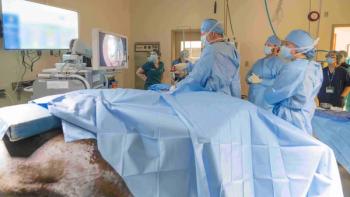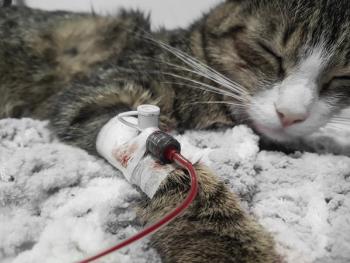
Brachycephalic airway syndrome, Part 1: Correcting stenotic nares
Help patients with this syndrome breathe easier with a simple surgical correction.
EDITOR'S NOTE: Surgery STAT is a collaborative column between the American College of Veterinary Surgeons (ACVS) and DVM Newsmagazine.
Brachycephalic airway syndrome is described in dogs and cats that have brachycephalic conformation (a short, wide head). The primary components of the syndrome are stenotic nares, an elongated soft palate and a hypoplastic trachea (most often seen in English bulldogs). All these features can be present, or the presence and severity of each component can vary. The result is altered airway pressures.
Syndrome effects
The smaller breathing lumens make for an increased respiratory effort, which is most apparent on inspiration. Fluid (or air) flow through a tube is described by Poiseuille's law that states that, in regard to the radius of a tube's lumen, flow is directly related to the radius raised to the fourth power. So small changes in airway size create vast changes in flow—especially in small patients with small airways. Over time, the increased work of breathing causes the secondary components of the syndrome—eversion of the laryngeal saccules and laryngeal collapse.
The increased resistance to airway pressure creates more work for the patient to move air in and out of its lungs. This creates problems during exertion or when exposed to high ambient temperatures when panting is needed to cool the body. These scenarios can create an obstructive airway crisis, hyperthermia or both. As the disease progresses and secondary changes occur, a crisis can occur with minimal stress or exertion. Chronic hypoxia creates pulmonary vasoconstriction and eventually pulmonary hypertension.
Commonly affected breeds are English bulldogs, French bulldogs, pugs, Boston Terriers, Pekingese, Pomeranians, Shih Tzus and boxers. Hypoplasia of the trachea is most common in English bulldogs and is likely responsible for a worse prognosis in this breed.
Most surgeons think that to prevent the development of the secondary components of brachycephalic airway syndrome, the patients should undergo surgery at a young age since there are reports of dogs as young as 6 months of age with laryngeal collapse. Performing corrective procedures is often done concurrently with spaying or neutering. Each patient needs to be assessed on an individual basis to determine which procedures are indicated.
Patient assessment
During the initial examination, evaluate patients for evidence of dyspnea. If open-mouth breathing alleviates dyspnea, the obstruction is likely nasal in origin. If dyspnea persists despite open-mouth breathing, soft palate and laryngeal lesions are likely present.
Preoxygenate animals before anesthetic induction. Examine the nares to determine whether the wing of the nostril impinges on the nares. First examine the nares while the patient is awake and then after anesthetic induction. During awake inspiration, animals with severely stenotic nares can be seen to suck the wing medially.
Upon induction, examine the palate and larynx. The length of the palate is deemed elongated when it comes past the level of epiglottis. Evaluate larynx function and look for evidence of collapse or dysfunction. Perform a thorough evaluation so that treatment can be tailored for each patient's needs.
Correcting stenotic nares
Most airway resistance comes from the nasal passages, so correction of stenotic nares can greatly reduce airway pressures (Figure 1). Stenotic nares are corrected with one of several resection techniques—alar wing amputation, punch resection, vertical wedge, horizontal wedge, alapexy and laser ablation. The goal of all techniques is to remove all or a portion of the alar wing to provide an unobstructed pathway for air to flow. These techniques have various levels of difficulty. Techniques described here are the more easily performed. Placing the patient in straight ventral recumbency and maintaining this position help create a symmetrical, cosmetic repair.
Figure 1: Note the stenosis of the nares by the medial pinching of wings. (Photo courtesy Joseph Hauptman, DVM, Dipl. ACVS, Michigan State University College of Veterinary Medicine.)
Alar wing amputation
The alar wing amputation (Trader's technique) was the original technique reported. The technique is simple and is performed as follows:
Figure 2: An intraoperative photo showing the Traderâs technique before achieving hemostasis. (Photo courtesy Joseph Hauptman, DVM, Dipl. ACVS, Michigan State University College of Veterinary Medicine.)
1. Place a No. 11 blade into the dorsal aspect of the nasal opening with the blade pointing ventrolaterally.
2. Incise to amputate the ventral alar wing.
3. Apply pressure for five to 10 minutes to provide hemostasis (Figures 2 & 3).
4. Allow the wound to heal by second intention; no suturing is needed.
5. Repeat the process on the other side.
Figure 3: An intraoperative photo showing the Traderâs technique after achieving hemostasis. (Photo courtesy Joseph Hauptman, DVM, Dipl. ACVS, Michigan State University College of Veterinary Medicine.)
6. Trim additional tissue as needed to attain symmetry.
Cosmesis is satisfactory after the site heals (10 to 14 days) (Figure 4). Complications of this techniques are rare. For some surgeons, this may be preferred in the smallest patients where the geometric excisions and closures can be demanding.
Punch resection
The punch technique allows for an identically sized piece of nasal wing to be resected from each side. A 2- to 6-mm punch is inserted into the meat of the rostral aspect of the nasal wing. The plug is grasped with thumb forceps and the base is excised with Metzenbaum scissors. The size is selected to leave a 2- to 3-mm rim of tissue for suturing with simple interrupted fine suture. Bleeding is controlled with gentle pressure with cotton-tipped applicators and suturing.
Vertical wedge
The vertical wedge procedure is a relatively easy technique that involves using a No. 11 blade to create upside-down V-shaped incisions in the rostral aspect of the wing and then removing this wedge. Similar to the punch technique, several interrupted sutures are placed.
For all techniques, postoperative Elizabethan collars are needed for 10 to 14 days to prevent self-trauma to the surgery site. In Part 2, I will discuss the landmarks and technique for surgery on the soft palate and larynx.
Figure 4: A healed nose one year after surgery using the Traderâs technique. (Photo courtesy Joseph Hauptman, DVM, Dipl. ACVS, Michigan State University College of Veterinary Medicine.)
Dr. Keats currently practices at VCA Veterinary Referral Associates in Gaithersburg, Md. He graduated from the Virginia-Maryland Regional College of Veterinary Medicine in 1999. He completed his surgical residency in 2005 with Chesapeake Veterinary Surgical Services and then became board-certified in 2006. He practices both orthopedic and soft tissue surgery.
Newsletter
From exam room tips to practice management insights, get trusted veterinary news delivered straight to your inbox—subscribe to dvm360.




